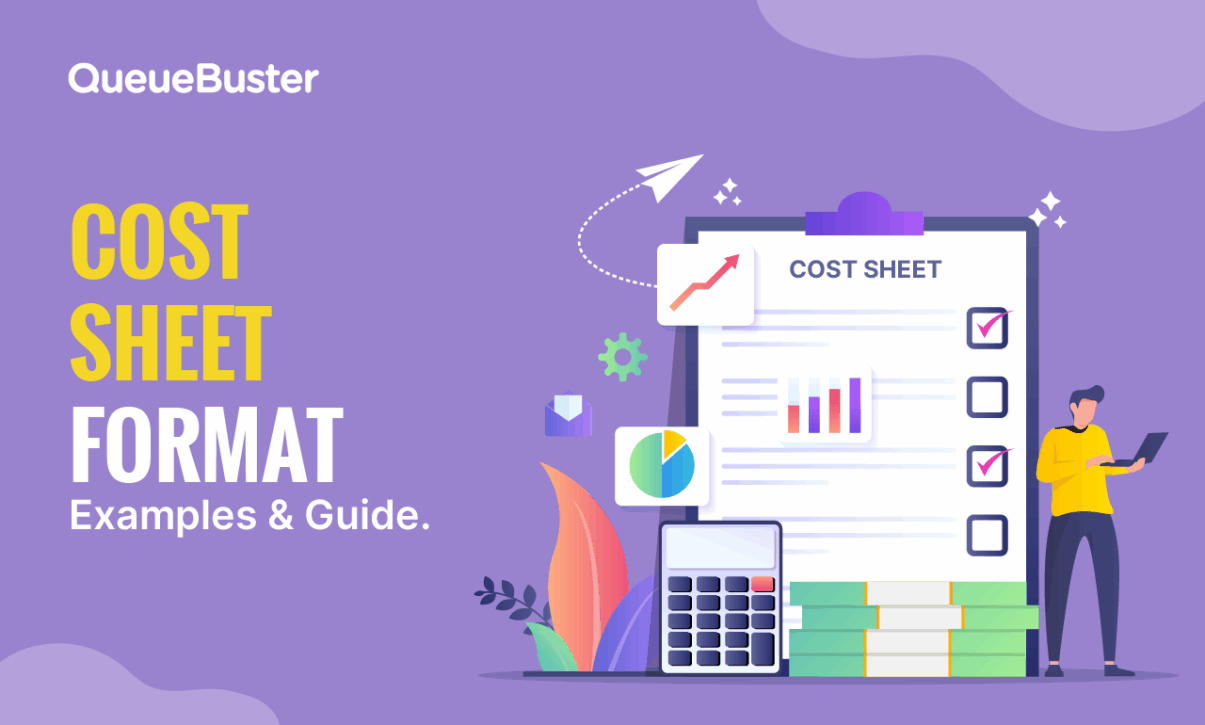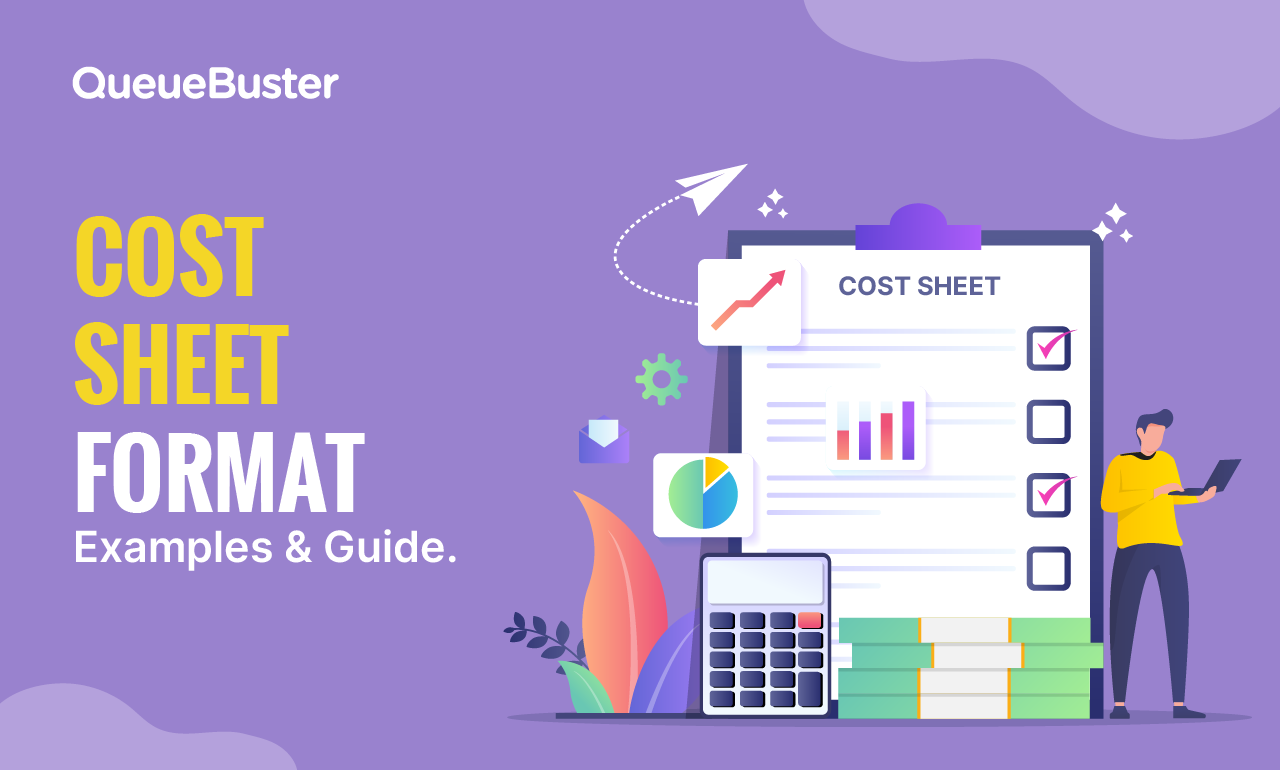
Cost Sheet Format: A Complete Guide With Examples
Cost Sheet Format: A Complete Guide With Examples

By Charu Gupta Published: April 29th, 2025
In this competitive business world, keeping track of costs is crucial for any company aiming to stay profitable. This is where a Cost Sheet comes in. Whether you’re a student, a business owner, or a finance professional, understanding cost sheets and cost sheet format can make a significant difference in decision-making, pricing, and budgeting.
In this blog, we’ll dive deep into the concept of a cost sheet, explore its importance, look at different types, break down its key components, understand the simple cost sheet format, and go through a real-world example.
Let’s begin!
What Is a Cost Sheet?
A cost sheet is a document that summarizes all the costs a business incurs to produce goods or services during a particular period.
It records direct costs (like materials and labor) and indirect costs (like administrative and selling expenses) systematically.
Simply put, it tells you:
- How much it costs to make a product.
- Where your money is going during production.
- What your final selling price should be to make a profit.
Think of a cost sheet as a detailed quick bill that a company prepares for itself to understand the true cost of its operations.
Why is a Cost Sheet Important?
A cost sheet is not just paperwork; it plays a vital role in business success. Here’s why:
- Pricing Decisions:
Helps set the right selling price by knowing the full production cost. - Cost Control:
Identifies areas where costs can be reduced without affecting quality. - Profit Analysis:
Shows whether the business is profitable or needs improvement. - Budget Preparation:
Assists in preparing future budgets and financial forecasts. - Transparency:
Builds trust with stakeholders, auditors, and management by showing clear cost data. - Comparison:
Makes it easy to compare costs over different periods or between products.
In short, a cost sheet format in cost accounting is a powerful management and strategic planning tool.
Types of Cost Sheets
Cost sheets can vary depending on the purpose and the nature of the business. Here are the main types:
1. Historical Cost Sheet
- Based on actual costs incurred during a past period.
- Useful for analyzing past performance and making future improvements.
2. Estimated Cost Sheet
- Based on predicted costs for an upcoming period or project.
- Helps businesses quote prices for tenders or new product launches.
3. Single Cost Sheet
- Focuses on the cost of producing one product or a single batch.
- Ideal for simple manufacturing setups.
4. Multiple Cost Sheet
- Compiles costs for different products or departments in one report.
- Suitable for diverse businesses with multiple product lines.
Businesses often prepare both historical and estimated cost sheets to maintain complete control over their financial planning especially after the emergence of digital payments.
Components of a Cost Sheet
A well-prepared cost sheet format has multiple layers, and each component is crucial. Here’s a breakdown:
1. Prime Cost
The total of all direct expenses related to production, such as:
- Direct Materials: Raw materials used.
- Direct Labor: Wages of workers directly involved.
- Direct Expenses: Other production-specific costs.
Formula:
Prime Cost = Direct Materials + Direct Labor + Direct Expenses
2. Factory/Works Cost
Prime Cost plus factory overheads (indirect production costs like factory rent, utilities, etc.)
Formula:
Works Cost = Prime Cost + Factory Overheads
3. Cost of Production
Works Cost plus administrative expenses (office salaries, stationery, etc.)
Formula:
Cost of Production = Works Cost + Administrative Overheads
4. Cost of Goods Sold (COGS)
Cost of Production adjusted with opening and closing stock of finished goods.
Formula:
COGS = Cost of Production + Opening Stock of Finished Goods – Closing Stock of Finished Goods
5. Cost of Sales
COGS plus selling and distribution expenses (advertising, delivery charges, etc.)
Formula:
Cost of Sales = COGS + Selling and Distribution Overheads
6. Profit
The difference between Sales Revenue and Cost of Sales.
Formula:
Profit = Sales – Cost of Sales
Cost Sheet Format
Here’s a standard format of a cost sheet for better clarity:
| Particulars | Amount (₹) |
| Direct Materials | |
| Direct Labor | |
| Direct Expenses | |
| Prime Cost | |
| Add: Factory Overheads | |
| Works Cost | |
| Add: Administrative Overheads | |
| Cost of Production | |
| Add: Opening Stock of Finished Goods | |
| Less: Closing Stock of Finished Goods | |
| Cost of Goods Sold (COGS) | |
| Add: Selling and Distribution Overheads | |
| Cost of Sales | |
| Add: Profit | |
| Sales Price |
Examples of a Cost Sheet
Let’s understand with a simple example.
XYZ Pvt Ltd produces 500 units of a product. Here’s their data for a month:
- Direct Materials = ₹2,00,000
- Direct Labor = ₹1,50,000
- Direct Expenses = ₹50,000
- Factory Overheads = ₹75,000
- Administrative Overheads = ₹30,000
- Selling and Distribution Overheads = ₹20,000
- Opening Stock of Finished Goods = ₹10,000
- Closing Stock of Finished Goods = ₹15,000
- Selling Price = ₹600 per unit
| Particulars | Amount (₹) |
| Direct Materials | 2,00,000 |
| Direct Labor | 1,50,000 |
| Direct Expenses | 50,000 |
| Prime Cost | 4,00,000 |
| Add: Factory Overheads | 75,000 |
| Works Cost | 4,75,000 |
| Add: Administrative Overheads | 30,000 |
| Cost of Production | 5,05,000 |
| Add: Opening Stock of Finished Goods | 10,000 |
| Less: Closing Stock of Finished Goods | 15,000 |
| Cost of Goods Sold (COGS) | 5,00,000 |
| Add: Selling and Distribution Overheads | 20,000 |
| Cost of Sales | 5,20,000 |
| Add: Profit (Calculated Below) | 80,000 |
| Sales Price (500 units × ₹600) | 3,00,000 |
Key Benefits of Preparing a Cost Sheet Format for Cost Accounting
- Better Cost Management:
Helps in spotting areas of wastage or over-spending. - Accurate Pricing:
Ensures that products are not underpriced or overpriced. - Informed Decision Making:
Management can decide on whether to continue, stop, or modify production lines. - Transparency:
Essential for internal audits and external inspections. - Competitive Advantage:
Companies with good cost control can price better and outperform competitors.
Final Thoughts
A well-prepared cost sheet format provides a roadmap to profitability. It not only reveals how much it costs to produce goods but also sheds light on how efficiently a business is running.
In a fast-changing market where every rupee matters and quick billing options are rising, mastering the art of creating and analyzing cost sheets is no longer optional—it’s essential.
Whether you’re a student preparing for exams, a startup trying to price your products, or a large manufacturer optimizing costs — a cost sheet is your first step toward financial clarity and business success.
Popular Posts

Why Table Ordering and QR-Based Menus Are Booming in UAE Restaurants
The UAE restaurant industry is evolving faster than ever. From luxury fine […]

5 Effective Tips To Manage Billing For Multiple Customers
Managing billing for multiple customers, especially during peak business hours, can be […]